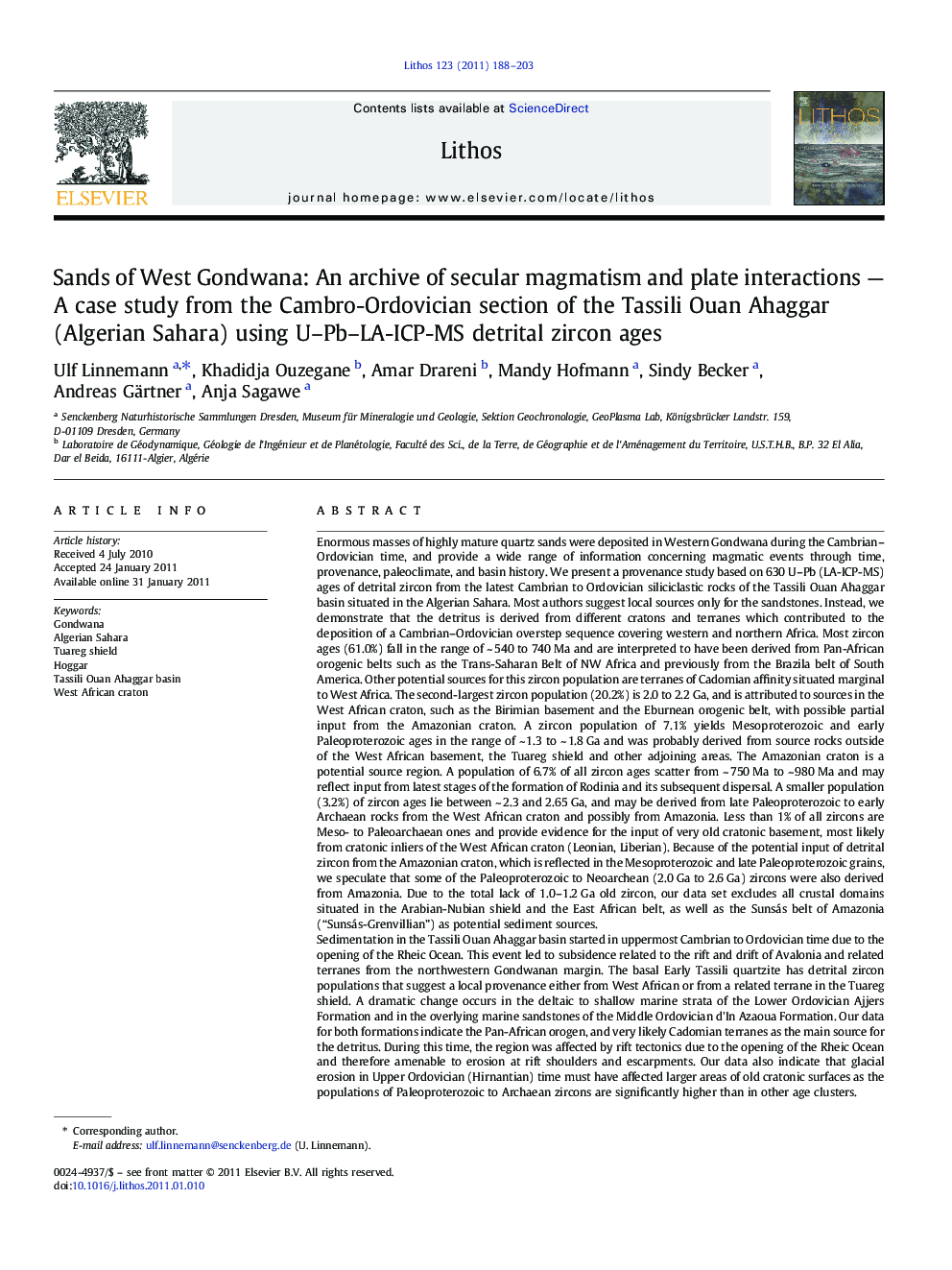| Article ID | Journal | Published Year | Pages | File Type |
|---|---|---|---|---|
| 4716796 | Lithos | 2011 | 16 Pages |
Enormous masses of highly mature quartz sands were deposited in Western Gondwana during the Cambrian–Ordovician time, and provide a wide range of information concerning magmatic events through time, provenance, paleoclimate, and basin history. We present a provenance study based on 630 U–Pb (LA-ICP-MS) ages of detrital zircon from the latest Cambrian to Ordovician siliciclastic rocks of the Tassili Ouan Ahaggar basin situated in the Algerian Sahara. Most authors suggest local sources only for the sandstones. Instead, we demonstrate that the detritus is derived from different cratons and terranes which contributed to the deposition of a Cambrian–Ordovician overstep sequence covering western and northern Africa. Most zircon ages (61.0%) fall in the range of ~ 540 to 740 Ma and are interpreted to have been derived from Pan-African orogenic belts such as the Trans-Saharan Belt of NW Africa and previously from the Brazila belt of South America. Other potential sources for this zircon population are terranes of Cadomian affinity situated marginal to West Africa. The second-largest zircon population (20.2%) is 2.0 to 2.2 Ga, and is attributed to sources in the West African craton, such as the Birimian basement and the Eburnean orogenic belt, with possible partial input from the Amazonian craton. A zircon population of 7.1% yields Mesoproterozoic and early Paleoproterozoic ages in the range of ~ 1.3 to ~ 1.8 Ga and was probably derived from source rocks outside of the West African basement, the Tuareg shield and other adjoining areas. The Amazonian craton is a potential source region. A population of 6.7% of all zircon ages scatter from ~ 750 Ma to ~ 980 Ma and may reflect input from latest stages of the formation of Rodinia and its subsequent dispersal. A smaller population (3.2%) of zircon ages lie between ~ 2.3 and 2.65 Ga, and may be derived from late Paleoproterozoic to early Archaean rocks from the West African craton and possibly from Amazonia. Less than 1% of all zircons are Meso- to Paleoarchaean ones and provide evidence for the input of very old cratonic basement, most likely from cratonic inliers of the West African craton (Leonian, Liberian). Because of the potential input of detrital zircon from the Amazonian craton, which is reflected in the Mesoproterozoic and late Paleoproterozoic grains, we speculate that some of the Paleoproterozoic to Neoarchean (2.0 Ga to 2.6 Ga) zircons were also derived from Amazonia. Due to the total lack of 1.0–1.2 Ga old zircon, our data set excludes all crustal domains situated in the Arabian-Nubian shield and the East African belt, as well as the Sunsás belt of Amazonia (“Sunsás-Grenvillian”) as potential sediment sources.Sedimentation in the Tassili Ouan Ahaggar basin started in uppermost Cambrian to Ordovician time due to the opening of the Rheic Ocean. This event led to subsidence related to the rift and drift of Avalonia and related terranes from the northwestern Gondwanan margin. The basal Early Tassili quartzite has detrital zircon populations that suggest a local provenance either from West African or from a related terrane in the Tuareg shield. A dramatic change occurs in the deltaic to shallow marine strata of the Lower Ordovician Ajjers Formation and in the overlying marine sandstones of the Middle Ordovician d'In Azaoua Formation. Our data for both formations indicate the Pan-African orogen, and very likely Cadomian terranes as the main source for the detritus. During this time, the region was affected by rift tectonics due to the opening of the Rheic Ocean and therefore amenable to erosion at rift shoulders and escarpments. Our data also indicate that glacial erosion in Upper Ordovician (Hirnantian) time must have affected larger areas of old cratonic surfaces as the populations of Paleoproterozoic to Archaean zircons are significantly higher than in other age clusters.Large parts of highly mature sands of the Cambro-Ordovician section in the Tassili Ouan Ahaggar basin were derived from a peneplain in the interior of Gondwana, that formed during Cambrian times. This peneplain was formed under warm-humid climate on a vegetation-free land surface and in an extreme corrosive environment that was influenced by high atmospheric pCO2 caused by Pan-African and Avalonian–Cadomian volcanism, volcanic activity related to the opening of the Iapetus, and Late Cambrian–Early Ordovician rift volcanism as well.
Research Highlights► The paper presents a first provenance study from the Tassilis based on zircon (U–Pb). ► Main source for the Ordovician sediments in Algeria is local (West Africa). ► A potential source for exotic Mesoproterozoic zircons grains is Amazonia. ► Arabian-Nubian shield and East African belt can be excluded as a source area. ► The Cambrian Gondwanan peneplain was formed under warm-humid climate.
